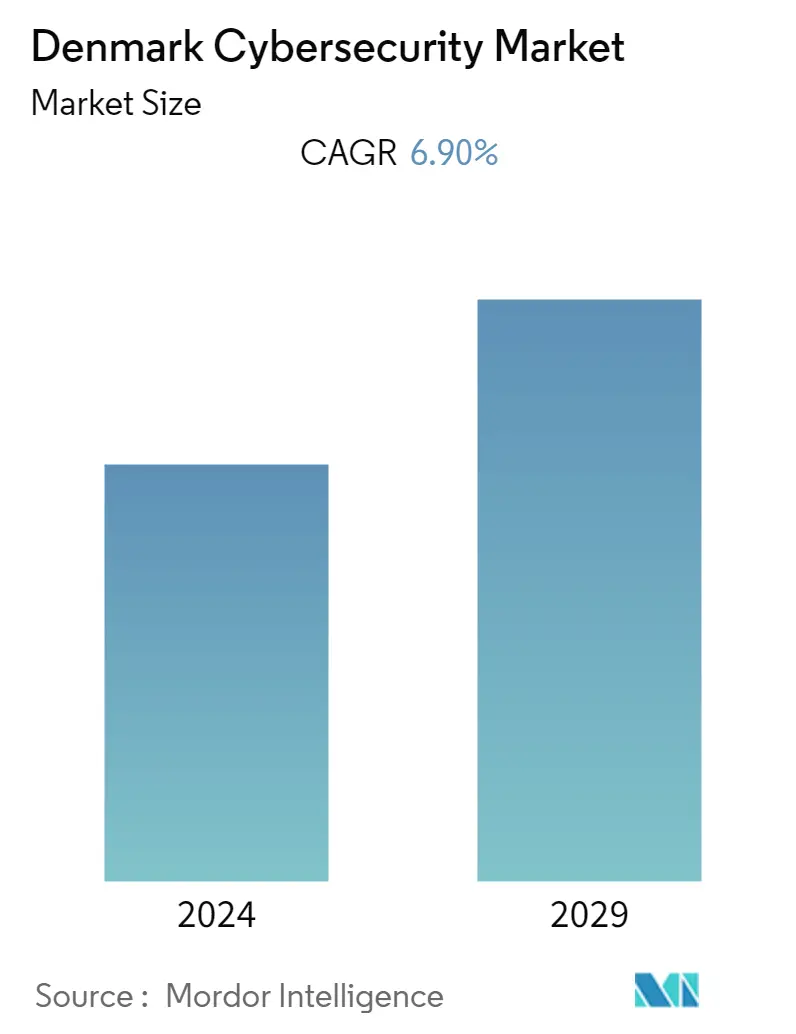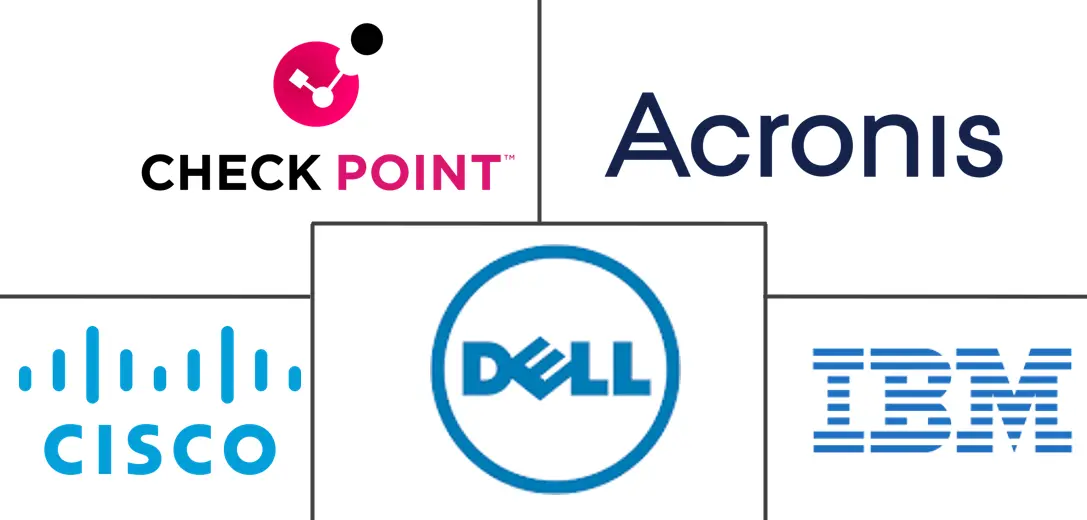Market Size of Denmark Cybersecurity Industry

| Study Period | 2019 - 2029 |
| Base Year For Estimation | 2023 |
| Forecast Data Period | 2024 - 2029 |
| Historical Data Period | 2019 - 2022 |
| CAGR | 6.90 % |
| Market Concentration | Low |
Major Players
*Disclaimer: Major Players sorted in no particular order |
Denmark Cybersecurity Market Analysis
The Denmark cybersecurity market is expected to register a CAGR of 6.9% during the forecast period of 2022-2027. The Denmark cybersecurity market is primarily driven by the upswing in cyberattacks happening in various end-user industries. Further, with the growing digitalization, cyberattackers are inventing new ways to conduct cyberattacks; such factors are expected to boost the demand for cybersecurity solutions in the country.
- Cybersecurity is primarily concerned with preventing unauthorized access to computers, networks, programs, and data. The importance of cybersecurity has recently grown as organizations, governments, and individuals collect, store, and send huge volumes of confidential information and data across networks.
- With the growing digitization across the end-user sectors in the country, cyberattacks also increased over the past few years. With new destructive practices in cyberspace, further cyberattacks can be carried out relatively easily, at low cost, and with a quite low risk for the attacker. This has led to increased demand for cybersecurity solutions to prevent these cyberattacks across end-user industries in this region.
- Companies in Denmark are accelerating data migration to the cloud, crafting new digital systems, and increasing the number of endpoints within their network architecture. Their developing dependence on third-party suppliers and service providers has presented attackers with new avenues into supply chains.
- To overcome these attacks, the country is making significant strides to strengthen the country's cybersecurity space. In September 2021, a new scheme was introduced in Denmark. D-seal (Digital Security) is the world's first labeling scheme that combines IT security and responsible data use in a single label. The D-seal objective is to increase digital trust for customers and consumers while driving digital accountability in businesses. To earn the D-seal, an organization must meet numerous IT security, data protection, and ethics criteria and pass a yearly audit.
- The governments of Sweden, Norway, and Finland are working together to implement 5G networks ahead of Europe. Denmark has also recently released its action plan to roll out 5G to facilitate and accelerate companies' digitization, especially for IoT automated production and intelligent transportation.
- Denmark's Government increased its cyber and information security efforts via the 2018-2023 Defense Agreement to invest DKK 1.4 billion in cyber and information security over the next few years to include better protection against cyberattacks by expanding the Centre for Cyber Security's sensor network for authorities and businesses.
- Denmark is one of the most prominent digitally advanced countries. This means that IT criminals have several opportunities to try to access or block the data of both citizens and businesses. The number of targeted ransomware assaults has indeed increased significantly.
- The market studied is dominated by major players, such as IBM Corporation, Cisco Systems Inc, Dell Technologies Inc., and many more, with a strong client base. These players are constantly providing increased and enhanced offerings. The market poses high barriers to the entry of new players. However, several new entrants have gained traction in the market.
- The COVID-19 pandemic positively impacted the market studied. Due to lockdown measures, most businesses were forced to interact digitally with their customers. A significant influx of customer data has increased the number of incidents and gateways for data breaches.
Denmark Cybersecurity Industry Segmentation
Cybersecurity solutions help an organization monitor, detect, report, and counter cyber threats, which are internet-based attempts to damage or disrupt information systems and hack critical information using spyware and malware, and phishing, to maintain data confidentiality.
The Denmark Cybersecurity Market is Segmented by offering (Security type (Cloud security, Data security, Identity Access Management, Network Security, Consumer security, Infrastructure protection) and services), Deployment (Cloud, On-premise), End-user (BFSI, Healthcare, Manufacturing, Government and Defense, and IT and telecommunication), and Geography.
| By Offering | |||||||||
| |||||||||
| Services |
| By Deployment | |
| Cloud | |
| On-premise |
| By End User | |
| BFSI | |
| Healthcare | |
| Manufacturing | |
| Government & Defense | |
| IT and Telecommunication | |
| Other End Users |
Denmark Cybersecurity Market Size Summary
The Denmark cybersecurity market is experiencing significant growth, driven by the increasing frequency of cyberattacks across various sectors and the rapid advancement of digitalization. As organizations, governments, and individuals in Denmark continue to collect and transmit vast amounts of sensitive information, the need for robust cybersecurity measures has become paramount. The rise in cyber threats, coupled with the growing complexity of digital infrastructures, has led to a heightened demand for cybersecurity solutions. This demand is further fueled by the country's push towards cloud migration, the expansion of digital systems, and the integration of IoT devices, which have created new vulnerabilities for cybercriminals to exploit. The Danish government and private sector are actively working to enhance cybersecurity frameworks, with initiatives like the D-seal labeling scheme and significant investments in cyber defense strategies.
The competitive landscape of the Denmark cybersecurity market is characterized by the presence of major global players such as IBM, Cisco, and Dell Technologies, alongside emerging entrants. These companies are continually innovating to meet the evolving cybersecurity needs of their clients. The market's growth is also supported by strategic collaborations and investments aimed at strengthening digital security across public and private sectors. The introduction of 5G technology and the ongoing digital transformation in industries like manufacturing and e-commerce are expected to further drive the demand for advanced cybersecurity solutions. As Denmark continues to advance its digital infrastructure, the importance of cybersecurity in safeguarding data and maintaining trust in digital systems remains a critical focus for both businesses and government entities.
Denmark Cybersecurity Market Size - Table of Contents
-
1. MARKET INSIGHTS
-
1.1 Market Overview
-
1.2 Value Chain Analysis
-
1.3 Porter's Five Forces Analysis
-
1.3.1 Threat of New Entrants
-
1.3.2 Bargaining Power of Buyers
-
1.3.3 Bargaining Power of Suppliers
-
1.3.4 Threat of Substitutes
-
1.3.5 Intensity of Competitive Rivalry
-
-
1.4 Impact of Covid-19 on the Market
-
-
2. MARKET SEGMENTATION
-
2.1 By Offering
-
2.1.1 Security Type
-
2.1.1.1 Cloud Security
-
2.1.1.2 Data Security
-
2.1.1.3 Identity Access Management
-
2.1.1.4 Network Security
-
2.1.1.5 Consumer Security
-
2.1.1.6 Infrastructure Protection
-
2.1.1.7 Other Types
-
-
2.1.2 Services
-
-
2.2 By Deployment
-
2.2.1 Cloud
-
2.2.2 On-premise
-
-
2.3 By End User
-
2.3.1 BFSI
-
2.3.2 Healthcare
-
2.3.3 Manufacturing
-
2.3.4 Government & Defense
-
2.3.5 IT and Telecommunication
-
2.3.6 Other End Users
-
-
Denmark Cybersecurity Market Size FAQs
What is the current Denmark Cybersecurity Market size?
The Denmark Cybersecurity Market is projected to register a CAGR of 6.9% during the forecast period (2025-2030)
Who are the key players in Denmark Cybersecurity Market?
IBM Corporation, Cisco Systems Inc, Dell Technologies Inc., Acronis International GmbH. and Check Point Software Technologies Ltd. are the major companies operating in the Denmark Cybersecurity Market.

